October 19, 2015, Bacolod City, Negros Occidental. When Atty. Jocelle Batapa-Sigue of Bacolod invited me to speak at the 2nd Trade and Tourism Expo and Conferences, entitled MassKaraCity 2015, I immediately agreed. I’ve long wanted to visit Bacolod, capital of the province of Negros Occidental. The only other time I’ve been there, I was just 17 years old and on a Goodwill Mission to Cebu, Bacolod and Iloilo together with the Most Outstanding Coeds of Metro Manila.
We stayed with foster parents in each city, paid courtesy visits to local government officials, and met with student leaders. To a city girl like me, Bacolod seemed laid back, especially when we were driving down roads lined with sugar plantations behind what seemed to be an endless string of trucks craning under the weight of sugarcane. What has changed, I wonder?
 What hit me this time is that Bacolod seems to be booming. Perhaps it was because of the Masskara Festival that was happening at the same time as the conference. Arriving at the airport, we were greeted by dancers dressed in colorful garb, prancing to the beat of drums. The main streets in the center of town were brightly lit, festooned with decorative buntings. We passed several malls, a sure indication of prosperity. The event itself was being held at the year-old SMX Convention Center Bacolod.
What hit me this time is that Bacolod seems to be booming. Perhaps it was because of the Masskara Festival that was happening at the same time as the conference. Arriving at the airport, we were greeted by dancers dressed in colorful garb, prancing to the beat of drums. The main streets in the center of town were brightly lit, festooned with decorative buntings. We passed several malls, a sure indication of prosperity. The event itself was being held at the year-old SMX Convention Center Bacolod.
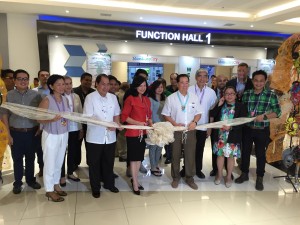
At the opening of MassKaraCity 2015, I listened intently to local government and business leaders speak of the city’s tourism and trade potential. I heard the passion in the voice of City Councilor Atty. Jocelle Batapa-Sigue as she spoke of the accomplishments in tourism and industry, especially in the IT-BPM sector, thanked all those who helped, and announced that she would no longer run for office in the upcoming elections. Jocelle chairs the Committee on Tourism, International and Local Cooperation and the Committee on Trade, Commerce and Industry of the Sangguniang Panlungsod of Bacolod.
I was happy to note that the IT-BPM industry is flourishing in Bacolod. Two years ago, Bacolod was recognized by the Department of Science and Technology as a center for excellence for information technology and business process outsourcing, joining the ranks of Metro Manila, Metro Cebu, and Metro Clark. That’s when I first met Jocelle, and was impressed by her fervor and efforts to develop the IT-BPM industry in Bacolod. Several locators have set up shop in Bacolod, like Teletech Philippines, Teleperformance Philippines, Data Solutions Outsourcing, Panasiatic Solutions-Bacolod, Interface Techno Philippines, A&E Global Fusion, Hit Rate Solutions, Alliance Call Centre, Solutionz Call Center, Magsaysay Global BPO, Transcom Philippines, BPO TeleQuest, Shorecloud Corp and Focus Direct Services. No wonder the place was booming!
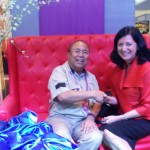
Tourism is definitely a strong pillar for Bacolod’s economy, what with its wildly successful Masskara Festival. I was fortunate to have met Atty. Juan V. Orola, Jr. (John) who was intimately involved in starting and developing the Masskara Festival. Formerly a diplomat, John served as Tourism Attache of the Philippine Embassy in Tokyo, Japan and the Philippine Consulate in Losa Angelas, USA, North and Latin America. He is a lawyer as well as a Doctor of Ecclesiastical Law. I also found out that he was a member of the Lower House representing Bacolod from 1998-2001. But what struck me most was his enthusiasm and commitment to develop Bacolod’s tourism potential.
John recounted the festival’s beginnings in 1980 during a period of severe crisis and tragedy. The global price of sugar had just dropped with the introduction of sugar substitutes in the United States, hitting Bacolod, which relied on sugarcane exports as its main source of revenues, at its core. To make things worse, Bacolod was reeling from the death of 700 Negrenses in a mid-water collision of inter-island MV Don Juan and tanker Tacloban City, throwing the 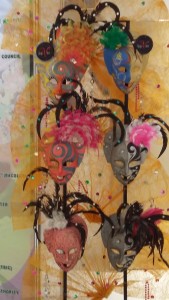 city into gloom. To bring the people out of the doldrums, the local government, business and civic groups and local artisans banned together to launch a festival of smiles. They called it Masskara, taken from the words mass (people) and cara (face) and had revellers wear masks with smiling faces. In essence, Bacolod declared it would not allow itself to be vanquished. And the city has not looked back since.
city into gloom. To bring the people out of the doldrums, the local government, business and civic groups and local artisans banned together to launch a festival of smiles. They called it Masskara, taken from the words mass (people) and cara (face) and had revellers wear masks with smiling faces. In essence, Bacolod declared it would not allow itself to be vanquished. And the city has not looked back since.
Because it was festival season, all the hotels and flights were full. I was booked at Luxur Hotel, or what used to be the Bacolod Convention Plaza Hotel, now home for Teleperformance Bacolod. It was safe, Jocelle promised, being in front of the Bacolod Police Headquarters. And though it was not in the center of town, it was just 50 meters from the Negros Organic Market and 20 meters from Aboy’s, the best Bacolod restaurant. I made a mental note to try out Aboy’s.
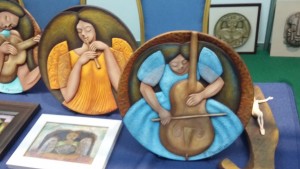 After the ribbon cutting on Friday, we toured the trade exhibition at SMX. I was impressed by the creativity of the local artists and the variety of products on display, from food to paintings and intricately woven baskets. Desserts appeared to be a strong point, with the abundance of sweets, a natural course given Bacolod is sugarland. All I remember from my first trip to Bacolod was piaya, but this time I was introduced to Napoleones, mango tarts, caramel tarts, barquillos, bizcocho, broas, and more. I kept getting suggestions to visit Calea and Felicia’s but didn’t have the time this trip.
After the ribbon cutting on Friday, we toured the trade exhibition at SMX. I was impressed by the creativity of the local artists and the variety of products on display, from food to paintings and intricately woven baskets. Desserts appeared to be a strong point, with the abundance of sweets, a natural course given Bacolod is sugarland. All I remember from my first trip to Bacolod was piaya, but this time I was introduced to Napoleones, mango tarts, caramel tarts, barquillos, bizcocho, broas, and more. I kept getting suggestions to visit Calea and Felicia’s but didn’t have the time this trip.
Bacolod seems to be a paradise for foodies, and everyone I met urged me to try chicken inasal. But since I shy away from chicken, I opted for seafood instead. The first night in Bacolod, I toyed with the idea of having dinner at Aboy’s but was told not to walk there as it was already late and dark; instead I just stayed in the hotel and worked on my presentation.
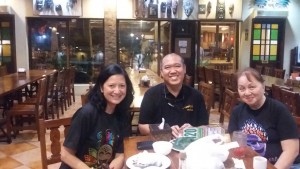
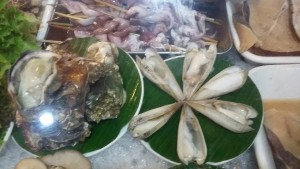
On my second night in Bacolod, the mayor’s wife Mrs. Josefina Puentevella (Tita Paching) brought me to Aboy’s and ordered a delicious repast of seafood. I was introduced to diwal (angel wing clams), squid fat, their version of laing, and I was hooked! We feasted on scallops, oysters and blue marlin. What made it more special was meeting its amiable owner. Tita Paching recounted how it grew from being a small eatery in 1992 catering to pharmaceutical reps to this big expansive restaurant we were eating in. She pointed out the owner’s wife who was behind the till, still hard at work.
Early the next day, Tita Paching picked me up and we heard mass at the Cathedral of San Sebastian, originally built in 1876. Seeing the familiar figure of San Sebastian tied to a tree with arrows sticking ut of him, I remembered my childhood. Every Sunday, we would go to mass at the Basilica of San Sebastian behind which we lived. I would stare at his statue at the main altar, and wonder how strong his faith was to be martyred for it. After mass, we visited the Organic Market, picked up a refreshing dayap and cucumber juice and then had breakfast at Luxur.
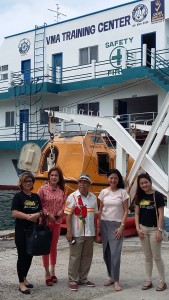
After this, Atty. John Orola came to pick me up and show me his school, The VMA Global College and Training Centers where they prepare students for lifetime careers ranging from maritime to tourism. It was interesting touring the school’s facilities, especially the MV VMA, a full mission simulator where students can experience how to navigate a vessel using the Poseidon simulator, maneuvering under various conditions and situations and avoiding collision. A group of students was then undergoing survival training, learning how to swim under difficult conditions and to jump from heights. There was an enclosed 28-foot lifeboat, which apparently had been used by Tom Hanks in the movie Captain Phillips that I wanted to enter, but we could not as survival training was ongoing. Next trip, I thought.
After VMA, we moved over to Sum-Ag, Bacolod City where we met Tomas “Tomiko” Claridad Casiano, a retired floral designer from Beverly Hills. When he decided to come back to the Philippines, Tomiko packed up his collection of over 2,000 vintage glass pieces in 66 crates, and built a two-story museum next door to his home to house his beloved collection. 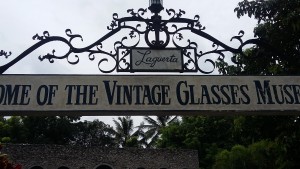 Opened to the public on December 12, 2012, Laguerta, home of the Vintage Glass Museum has been recognized as the largest collection of depression glasses outside of the United States, and the first in Asia.
Opened to the public on December 12, 2012, Laguerta, home of the Vintage Glass Museum has been recognized as the largest collection of depression glasses outside of the United States, and the first in Asia.
Tomiko’s love story with vintage glasses began when he searched for interesting vases for the floral creations he would use in the homes of the rich and famous. Attracted to vintage glass, particularly depression glasses manufactured in the Unites States from 1904 to 1940, Tomiko had his collection of dinnerware, decanters, commemorative plates and decorative objects arranged by color, from yellow to amber, pink, ruby, fire, green, aquamarine, cobalt blue and delphite which is an opaque blue glass.
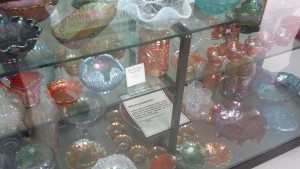 He eagerly showed us the stars of his collection, explaining the difference between carnival glasses, which are pattern-molded iridescent glasses sprayed with metallic salts while the glass was hot, and opalescent glasses, which have two layers of glass: one colored and the other clear. He explained that washing the latter several times would wash away its color completely. He showed us his Vaseline collection, which is no longer being made because it requires uranium to produce its yellow to yellow green color; a Jadite collection that is milk green, a pearlized mustard collection that is milk yellow, and a milky white collection.
He eagerly showed us the stars of his collection, explaining the difference between carnival glasses, which are pattern-molded iridescent glasses sprayed with metallic salts while the glass was hot, and opalescent glasses, which have two layers of glass: one colored and the other clear. He explained that washing the latter several times would wash away its color completely. He showed us his Vaseline collection, which is no longer being made because it requires uranium to produce its yellow to yellow green color; a Jadite collection that is milk green, a pearlized mustard collection that is milk yellow, and a milky white collection.
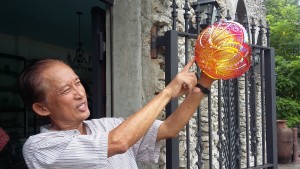
Tomiko held up some bowls to the sun so that we could appreciate the patterns. I was intrigued by a night lamp he held up that was etched all around with a ship, a spouting whale, a swimming whale and anchors. I imagined it lit by a candle, and a young mother during the depression telling her child a bedtime story of maritime adventure as the flickering light of the candle threw shadows on the wall. Another interesting item was a bedtime jar, whose cover was actually an upturned glass. Tomiko had two of those in his collection.
Listening to his stories and watching him as he toured us around, I was impressed with Tomiko. Here was a man, totally unassuming, who loved what he did and was eager to share it with the world. When I asked when visiting hours for his museum was, he explained that we had to call ahead to make a reservation so he could be there. He did not have staff to manage the museum, and did everything himself, afraid that they would not take care of his collection as well as he did.
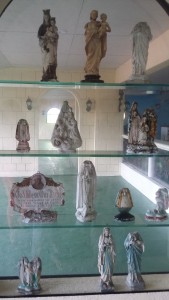 Tomiko then invited us to visit the church of San Juan Nepomuceno that he has been supporting. The church housed his Escayola Collection of Mutilated Religious Arts. Since many Catholic families in the Philippines have “santos” or images of saints made of escayola (plaster of Paris), owners are unsure what to do with them when they break. Missing limbs or heads, the “santos” are no longer displayed. As it is considered bad luck to throw them, they are instead buried.
Tomiko then invited us to visit the church of San Juan Nepomuceno that he has been supporting. The church housed his Escayola Collection of Mutilated Religious Arts. Since many Catholic families in the Philippines have “santos” or images of saints made of escayola (plaster of Paris), owners are unsure what to do with them when they break. Missing limbs or heads, the “santos” are no longer displayed. As it is considered bad luck to throw them, they are instead buried.
One night, Tomiko dreamt that he was being asked by God to take care of broken religious icons made of escayola. The very next day, a neighbor came by and gave him a broken statue of a saint that he had unearthed while digging in his garden. This started his collection, as news spread and friends and even people he did not know would come up to him and gift him with their broken statues. I asked him if he knew who all these “santos” represented, and he admitted that he did not know all of them, but that a researcher was helping him identify the statues for proper labeling. I am sure that just like his vintage glass collection, Tomiko’s escayola collection will someday be recognized as unique and outstanding.

My last stop before going to the airport for my return trip to Manila was the stadium. I was adamant to catch even one Masskara dance, and was lucky to see the group that performed in Hong Kong. It was an amazing performance, and a fitting end to my quick trip to Bacolod City. I vowed to come back next year for the Masskara festival and stay the entire weekend. Now to look for tickets and book a hotel.

Thank you for coming to Bacolod and experiencing what we have to offer. May your fond memories bring you back soon!
Thanks, Maricar, and congratulations once again!